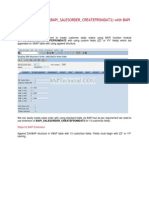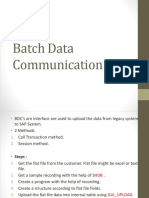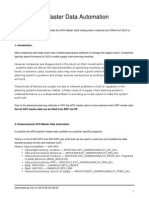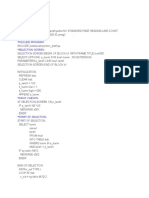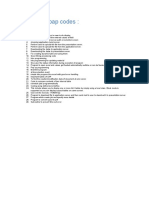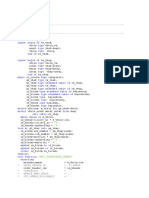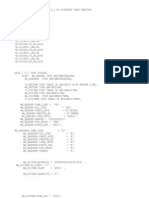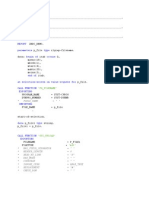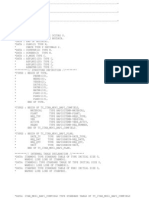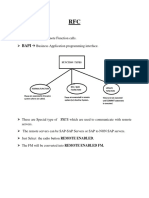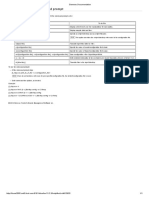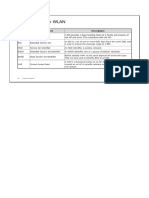4️⃣
BAPI
1. Introduction
BAPI stands for Business Application Programming Interface
BAPI is a technique which is used to conduct a large scale data migration
BAPIs in the SAP Systems are implemented as RFC enabled function modules.
When we create a business object for a RFC enabled function module and we merge it with
the function module then we call it a BAPI.
i.e. BAPI = RFC Function Module + Business Object
BAPI is always preferable as compared to BDC for data migration.
2. Why BAPI is more preferable as compared to
BDC ?
1. BDC
Upgradation :- When we go for upgradation, there might be possibility to change the screen
elements or numbers depending on the requirement. In that case, our existing BDC Program
BAPI 1
� may or may not work. Unless and util we prepare new BDC recording, So, in that case we
can’t use the OLD BDC Program.
Faster :- BDC run through the screen flow to update the database. So, It is slower as
compared to BAPI.
2. BAPI
Upgradation :- In BAPI, SAP promises that they are going to keep the old BAPI and for new
functionality they will provide an upgraded BAPI. Until we write a new BAPI Program, we
can use the existing BAPI Program.
Faster :- BAPI directly updates the database, So it is faster as compared to BDC.
3. Some Important BAPIs for Data Migration
Create and Change Material Master Data :-
BAPI_MATERIAL_SAVEDATA
Creating a Purchase Order :-
BAPI_PO_CREATE1
4. Requirement
We will upload the below material data from notepad using BAPI.
BAPI 2
� 5. Implementation
Step 1 :- We will create a type structure and internal table for the same.
Step 2 :- We will use At Selection Screen on value request event and F4_Filenname method
to pick our file from local system.
BAPI 3
� Step 3 :- Then In Start of Selection Event we will upload our File using GUI_UPLOAD
method.
Step 4 :- Then we will loop on our internal table.
Step 5 :- Inside the loop we will call the BAPI_MATERIAL_SAVEDATA function module.
BAPI 4
� Step 6 :- For the HEADATA parameter, we will create a work area and in that work area we
will pass MATERIAL, IND_SECTOR, MATL_TYPE, BASIC_VIEW.
Step 7 :- We will create a work area for CLIENTDATA and we will pass unit of
measurement into it.
BAPI 5
� Step 8 :- Whatever data you will pass in CLIENTATA, you will have to mark it as TRUE in
CLIENTDATAX parameter.
Step 9 :- Now we will create a internal table for MATERIALDESCRIPTION parameter and
we will pass our material description and language in this table.
BAPI 6
� and we will pass this into MATERIALDESCRIPTION parameter.
Step 10 :- We will create a return work area for the RETURN parameter.
then we will pass the work area into RETURN parameter.
Step 10 :- Just before ending of loop we will append the RETURN work area into internal
table and we will clear the description internal table.
Step 11 :- After the ending of loop we will use DISPLAY our return table.
BAPI 7
� 6. Code
TYPES : BEGIN OF TY_MATERIAL,
MATNR TYPE MATNR,
MBRSH TYPE MBRSH,
MTART TYPE MTART,
MAKTX TYPE MAKTX,
MEINS TYPE MEINS,
END OF TY_MATERIAL.
DATA : LT_MATERIAL TYPE TABLE OF TY_MATERIAL,
LS_MATERIAL TYPE TY_MATERIAL.
DATA : LV_FILE TYPE STRING.
DATA : LS_HEADDATA TYPE BAPIMATHEAD.
DATA : LS_CLIENTDATA TYPE BAPI_MARA.
DATA : LS_CLIENTDATAX TYPE BAPI_MARAX.
DATA : LT_DESCRIPTION TYPE TABLE OF BAPI_MAKT,
LS_DESCRIPTION TYPE BAPI_MAKT.
DATA : LT_RETURN TYPE TABLE OF BAPIRET2,
BAPI 8
� LS_RETURN TYPE BAPIRET2.
PARAMETERS : P_FILE TYPE LOCALFILE.
AT SELECTION-SCREEN ON VALUE-REQUEST FOR P_FILE.
CALL FUNCTION 'F4_FILENAME'
EXPORTING
PROGRAM_NAME = SYST-CPROG
DYNPRO_NUMBER = SYST-DYNNR
FIELD_NAME = ' '
IMPORTING
FILE_NAME = P_FILE.
START-OF-SELECTION.
LV_FILE = P_FILE.
CALL FUNCTION 'GUI_UPLOAD'
EXPORTING
FILENAME = LV_FILE
* FILETYPE = 'ASC'
HAS_FIELD_SEPARATOR = 'X'
* HEADER_LENGTH = 0
* READ_BY_LINE = 'X'
* DAT_MODE = ' '
* CODEPAGE = ' '
* IGNORE_CERR = ABAP_TRUE
* REPLACEMENT = '#'
* CHECK_BOM = ' '
* VIRUS_SCAN_PROFILE =
* NO_AUTH_CHECK = ' '
* FILENAME1 = ' '
* IMPORTING
* FILELENGTH =
* HEADER =
TABLES
BAPI 9
� DATA_TAB = LT_MATERIAL
* CHANGING
* ISSCANPERFORMED = ' '
EXCEPTIONS
FILE_OPEN_ERROR = 1
FILE_READ_ERROR = 2
NO_BATCH = 3
GUI_REFUSE_FILETRANSFER = 4
INVALID_TYPE = 5
NO_AUTHORITY = 6
UNKNOWN_ERROR = 7
BAD_DATA_FORMAT = 8
HEADER_NOT_ALLOWED = 9
SEPARATOR_NOT_ALLOWED = 10
HEADER_TOO_LONG = 11
UNKNOWN_DP_ERROR = 12
ACCESS_DENIED = 13
DP_OUT_OF_MEMORY = 14
DISK_FULL = 15
DP_TIMEOUT = 16
OTHERS = 17.
LOOP AT LT_MATERIAL INTO LS_MATERIAL.
LS_HEADDATA-MATERIAL = LS_MATERIAL-MATNR.
LS_HEADDATA-IND_SECTOR = LS_MATERIAL-MBRSH.
LS_HEADDATA-MATL_TYPE = LS_MATERIAL-MTART.
LS_HEADDATA-BASIC_VIEW = 'X'.
LS_CLIENTDATA-BASE_UOM = LS_MATERIAL-MEINS.
LS_CLIENTDATAX-BASE_UOM = 'X'.
LS_DESCRIPTION-LANGU = SY-LANGU.
LS_DESCRIPTION-MATL_DESC = LS_MATERIAL-MAKTX.
APPEND LS_DESCRIPTION TO LT_DESCRIPTION.
BAPI 10
� CLEAR LS_DESCRIPTION.
CALL FUNCTION 'BAPI_MATERIAL_SAVEDATA'
EXPORTING
HEADDATA = LS_HEADDATA
CLIENTDATA = LS_CLIENTDATA
CLIENTDATAX = LS_CLIENTDATAX
* PLANTDATA =
* PLANTDATAX =
* FORECASTPARAMETERS =
* FORECASTPARAMETERSX =
* PLANNINGDATA =
* PLANNINGDATAX =
* STORAGELOCATIONDATA =
* STORAGELOCATIONDATAX =
* VALUATIONDATA =
* VALUATIONDATAX =
* WAREHOUSENUMBERDATA =
* WAREHOUSENUMBERDATAX =
* SALESDATA =
* SALESDATAX =
* STORAGETYPEDATA =
* STORAGETYPEDATAX =
* FLAG_ONLINE = ' '
* FLAG_CAD_CALL = ' '
* NO_DEQUEUE = ' '
* NO_ROLLBACK_WORK = ' '
IMPORTING
RETURN = LS_RETURN
TABLES
MATERIALDESCRIPTION = LT_DESCRIPTION
* UNITSOFMEASURE =
* UNITSOFMEASUREX =
* INTERNATIONALARTNOS =
* MATERIALLONGTEXT =
* TAXCLASSIFICATIONS =
BAPI 11
� * RETURNMESSAGES =
* PRTDATA =
* PRTDATAX =
* EXTENSIONIN =
* EXTENSIONINX =
.
APPEND LS_RETURN TO LT_RETURN.
CLEAR : LT_DESCRIPTION.
ENDLOOP.
CL_DEMO_OUTPUT=>DISPLAY( LT_RETURN ).
7. Output
8. Checking data in MARA TABLE
BAPI 12




























